The clamor for this column to add even more Canadians, and even more writers named Adam, is finally heard! Let’s everyone welcome writer Adam X. Smith as the newest regular member of our reaving bunch of reviewers!
The Superior Spider-Man #16 (Marvel, $3.99)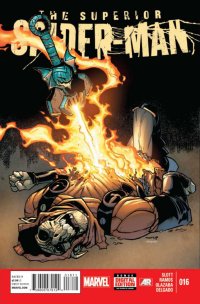
By Adam X. Smith
For the record, whilst I do like the character on paper and have been following the exploits of his Ultimate Universe successor with great interest, I’ve never been much of a reader of Spider-Man comics. I never got involved in the bitchy back and forth over who was better out of Betty and Veronica or whatever their names are.* I never liked the Venom/symbiote breakout characters, or the ridiculous plot-twists or the constant reworking of the character to fit whatever fad was happening at the time. And I goddamn hated the Amazing Spider-Man film, and everything I hear about the sequel makes me feel just that slightest bit more cynical and pessimistic about the whole thing.
But I get it, guys – web-swinging is cool. When he’s good, Peter Parker is a great character to get to play with. He’s one of us – we share in his glories and foibles, his ecstatic victories and crushing defeats. Spider-Man has never not been a relevant character. Well, except when they tried to make him a clone or give him extra arms or put him in that ridiculous Iron Spider armour or wrote his marriage out of continuity in order for Aunt May – who by now has surely gone through enough – to keep puttering around.
So how do I start my career writing comic reviews? By jumping head-first into the sweaty convoluted mess of post-revamp Spidey-books, not even at the start of a story arc but at the act break. The opening page – in lieu of a bunch of stodgy backstory filling – in as I’ve come to expect from mainstream comics – provides us with a Daily Bugle frontpage spread of the Superior Spider-Man** hacking the screens of Times Square to out Phil Urich, nephew of Daily Bugle staple Ben Urich, as perennial Spider-menace the Hobgoblin***. This leads to an incident in which Urich goes bugnuts in the Bugle offices, holding his girlfriend hostage before he is subdued by Spidey and his army of giant Spider-mechs and taken into custody, only to be busted out before he even makes it to prison. By whom, you ask? Oh, just some guy by the name of Osborn who has been living in the sewers recruiting people to become his army of Goblin supercriminals and has taken to calling himself the Goblin King. Ugh.
Okay, here’s the thing. Leaving aside for a second how Spider-Man of all people hacking every TV in New York to deliver a call for the silent majority to essentially lynch a complete stranger as a criminal doesn’t jolt anybody’s bullshit detector whatsoever (which for those just tuning in is problematic enough on its own in this day and age), the fundamental disconnect I have with the stringing along of this particular plot is not just how nobody has figured out that this is not the real Spider-Man besides two characters I have no previous knowledge of but who apparently know enough about Peter to smell a rat – that includes everyone at the Bugle, the now inexplicably pro-Spidey Mayor J. Jonah Jameson, the constantly too-busy-to-deal-with-him Avengers and presumably even his own family.
But it’s also the problem of how his sudden turn from being a friendly neighbourhood vigilante who saves kids from burning buildings and is loved and respected by most New Yorkers has suddenly become a well-over-the-borderline sociopath with an army of mechanised robot spiders and Spider-goons and technology to rival S.H.I.E.L.D. hasn’t raised as much as an eyebrow from the public at large. I mean, I know the Bugle have been smearing his name as a menace for decades, but I have to believe that the common people aren’t that gullible. Add to that, for all his bluster about being a Superior Spider-Man, Otto-as-Peter is not only a dick, but he’s also a terrible superhero. Apart from his failure to ensure Hobgoblin gets to prison without incident and his general dismissiveness when called on it, his blinkered attempts at taking care of the big fish has left a lot of small potatoes on the field for Stormin’ Norman to gobble up and fill the ranks of his Goblin syndicate. On that subject, why isn’t Spidey hunting down Osborn with the same resolve? He doesn’t even seem to have time for MJ or Aunt May anymore.
Maybe I need to read the series more, but it’s these little things that gnaw away at the corners, keeping me from completely accepting the premise. This isn’t Breaking Bad, where the antihero’s actions come with the perfect alibi – his outward meekness and humdrum life hide the heart of a stone-cold killer and manipulator. He’s fucking Spider-Man, the kid-brother of the superhero pantheon! All I can think of by way of explanation is that New Yorkers are stupid and that Octavius has been missing a trick all these years.****
The good news is that the book isn’t that bad. Asides from my problem with the basic premise, the plot is self-contained enough to not require too much research, Dan Slott’s dialogue is clipped and naturalistic asides from the odd typo (yes, I’m a stickler when it comes to bad copy and no, when you’re running one of the biggest comic publishers in the world there isn’t any excuse for it), and Humberto Ramos’ art is expressive and cartoony without feeling slapdash. If I had any investment in the title I’d probably rate it higher, but this was a good chance to sink my teeth into something current. I might pick it up again to see how things develop, and to see how many more Spider-references I can cram into one review. I won’t pin my hopes on it, though.
*By the way, I expect people to have the decency to know when I’m being sarcastic.
**For those five people who don’t know already, the Superior Spider-Man is Otto Octavius, aka Doc Ock, having mindswapped with and killed Peter Parker in his previous body.
***For those without access to Wikipedia, there have been others, and there is some tangential continuity nodding involved, with the original Hobgoblin taking a cut from Urich for… I dunno, name rights, I guess. Never knew insane supervillains were so picky about their trademark getting exploited. Imagine, though, applying that logic to every supervillain identity that’s ever been co-opted, and what it would do to the Marvel universe’s legal system – frivolous lawsuits flying left and right.
****For the record, I have no axe to grind with the people of New York. Your state looked very pretty from the other side of the Canadian border when I visited Niagra Falls.
Rating: Out of a Possible 5 Stars




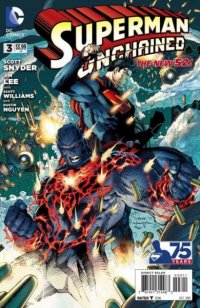 Superman Unchained #3 ($3.99, DC)
Superman Unchained #3 ($3.99, DC)
by D.S. Randlett (@dsrandlett)
It’s hard to pinpoint what the turning points really are. Wednesday, it felt like the United States reached one in the sentencing of Chelsea (nee Bradley) Manning. It seemed as if the continual bifurcation of civilian and military governments seemed to have come full circle, where an act in the interest of the civilian public resulted in a harsh sentence from the military state. The sentencing of Chelsea Manning was one more link in a chain that stretches back to the World War II effort, which would in turn give birth to the Cold War and the modern espionage apparatus. The war effort would also change the way America looked at war: we would never again see anti-war mobilizations on the scale of those in the lead up to the first World Wars, and the once strong progressive movements (movements, it should be noted, fed by a sense of civilian-citizenship) would wither into shadows.
In 1938, on the eve of World War II, a couple of teenagers would, possibly by accident, channel the anxieties and desires of the era’s people’s movements into Superman. It wasn’t long before he was helping to fix neighborhoods by spurring government investment in them, or daring Stalin and Hitler to settle things among themselves before spilling the blood of the proletariat. Superman was Hercules and Samson, sure, but he was also Eugene Debs, an avatar of the heroism of principle and civic action.
Wednesday may or may not have been a tipping point for the country, but it was sure as hell a tipping point for Scott Snyder and Jim Lee’s Superman Unchained. For its first two issues, the new flagship series for the genre’s flagship character had been the best Superman title since the new beginning of the New 52 by dint of Snyder finding the right voices for the characters. Superman, Clark, Lois, Jimmy, Luthor, they all just sounded right again. Nothing much was happening, though, and there was little indication that this series would be about anything. Luthor was up to something fishy, and General Sam Lane showed up with the new villain, Wraith, to announce that he had a beef with Superman. This third issue shows things starting to add up. We still don’t quite know what Luthor is up to, but Snyder slows the action down a bit here to set up some serious stakes for Superman, and they aren’t just the threat of physical violence at the hands of the series’ new (semi)villain character, Wraith.
Snyder has said in interviews here and there that he wants to present us with a villain that can put Superman on his ass for a bit. And yeah, Wraith kicks Superman across Utah for a bit, but at this point seeing Superman get his butt kicked is a bit old hat. No, the more interesting threat comes from General Lane, who presents a compelling ideological foil for Superman, and tells a story that inverts the mythology of Superman in a fun and almost meta kind of way. In 1938, a group of American scientists sent an equation out into space that “added up to more than the sum of its parts,” a message from a humanity standing on the brink expressing a desire to be better. Moments later, an ship lands containing a mysterious visitor from another world. In the present day, this visitor, now called Wraith, lives 800 feet below in a government facility called The Machine.
The Machine is, much like Wraith, another fulfillment of the “dark mirror” trope. Instead of mirroring Superman, it’s a mirror of the Fortress of Solitude. Whereas the “new” Fortress is a satellite, The Machine is underground. It is littered with trophies that will look familiar to anyone who’s been to the Udvar-Hazy complex, rather than the last memorials of lost cultures or animals that are the last of their kind. Most disturbingly, there is even an analog for Kandor, a little bottled building from Nagasaki, which Wraith destroyed to give the appearance of there being a second atom bomb.
It is here, in this monument to the United States’ global domination, that General Lane points an accusatory finger at Superman, and calling him a coward. According to Lane, Superman could be saving more lives if he concerned himself with taking out the maniac dictators of the world rather than rescuing people from falling space stations or crashing planes. Lane tells Superman this while standing in front of a graphic showing the decrease in territories that were a threat to the “Free World.” It’s a crucial scene, well written and effectively drawn. It’s also absolutely chilling in light of recent events concerning the detention of Glenn Greenwald’s partner, David Miranda, the sentencing of Chelsea Manning, and the continued pursuit of Edward Snowden. It’s a scene that speaks to this feeling in the air that the Western military structure has turned its back of what being “The Free World” means in the pursuit of mission completion. Lane is every old man who urged you to join the military instead of the Peace Corps. The name of the endeavour itself, The Machine, calls to mind a system of power that has eschewed humane systems of governance and empathy in favor of the calculated exercise of power. It calls to mind the governments of “The Free World” turning their backs on its citizenry, effectively saying, “We don’t need you, and you don’t matter.” Snyder’s script doesn’t quite have the panache of his Batman work, but he has a finger on something more vital here. Snyder, and by extension Superman, may, have something to say after all. At any rate, I can’t wait to find out what Superman’s response will be.
Rating: 




Out of a Possible 5 Stars
Got Dem Ol’ Kozmik Blues Again, Mama!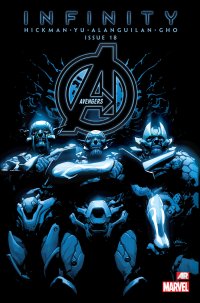
Avengers #18 (Marvel, $3.99)
Avengers Assemble #18 (Marvel, $3.99)
Daredevil #30 (Marvel, $2.99)
As various Avengers head for outer space (can’t let the Guardians of the Galaxy one-up them, right?), Marvel’s next big spacebuckling project gets up to speed this week. Interestingly, though, the week’s most entertaining cosmic adventure takes place on the mean streets of Hell’s Kitchen.
Last week’s Infinity #1 showed the strengths that Jonathan Hickman’s careful planning brings to a corporate-driven superhero epic. Avengers #18 is a more or less “obligatory” early chapter in the story, but it overcomes that handicap with sharp execution.
In this issue, Captain America leads the various Avengers and multi-galactic teams into their first encounter with The Builders, and it’s not exactly a spoiler to say that their carefully contrived plans, and daring improvisation, provide them (and the reader) with an illusory sense of victory-after all, the story’s barely begun; it’s like watching 24 or Strike Back: if we’re only on episode two or three, we know that any successes are transitory, and about to be undone. And, of course, that’s what we get here, as Avengers #18 ends with the threat to humanity (and its interstellar brethren) revealed as monstrously greater than anyone could have anticipated-i.e., it would appear that we’re fucked. But Hickman’s script is tight and terse, with good attention to detail in the planning, and appropriate contrast in styles between Cap, Gladiator, Shang-Chi, Hawkeye, etc. And even if this chapter is a bit perfunctory in a structural sense, Lenil Yu and inker Gerry Alanguilan bring us all the glorious space-battle action you could ask for; if anything, this is probably an even more visually impressive issue than Jim Cheung’s Infinity #1.
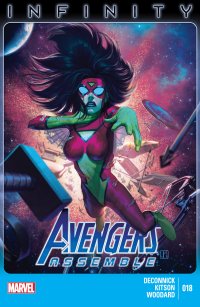 One nice thing about Infinity is the relatively manageable size of the project: outside of the Infinity/Avengers/New Avengers continuity, there are only three “tie-in” issues from other titles. Avengers Assemble #18 is the first of them, and while it’s a typically thoughtful, entertaining outing from writer Kelly Sue DeConnick, with classically old-school superhero art from Barry Kitson and Gary Erskine, it’s somewhat hampered by a scheduling glitch on Marvel’s part.
One nice thing about Infinity is the relatively manageable size of the project: outside of the Infinity/Avengers/New Avengers continuity, there are only three “tie-in” issues from other titles. Avengers Assemble #18 is the first of them, and while it’s a typically thoughtful, entertaining outing from writer Kelly Sue DeConnick, with classically old-school superhero art from Barry Kitson and Gary Erskine, it’s somewhat hampered by a scheduling glitch on Marvel’s part.
Readers of DeConnick’s Captain Marvel know that in Captain Marvel #14, the conclusion of the “Enemy Within” crossover with Avengers Assemble, Carol Danvers was given a sort of “soft reboot”: to save the life of a friend, she exercised her power of flight one last time, in the face of a brain lesion that would “destroy her personality” when she did so. Exactly what this meant was (deliberately) not spelled out, leaving the story to be picked up in Captain Marvel #15… which isn’t out yet. Unfortunately, both of this week’s Avengers books feature a more or less normal Carol Danvers going about her business of saving the universe; at the very least she hasn’t lost any of her pilot training or confidence, as she coolly informs Captain America that she’s a better pilot than he is. Avengers Assemble #18 spins a Spider-Woman tale off the main events of Avengers #18, but it’s clearly written as a followup to the as-yet unreleased Captain Marvel #15: Jessica Drew is musing on her friend Carol’s transformation, but apart from the fact that Carol seems not to remember that she once hooked up with Hawkeye, we really don’t get a feel for what’s up with her; neither, then, do we feel what’s at stake for Jessica and their friendship. Fortunately, that structural gaffe isn’t enough to derail an action-packed space adventure, but it’s clear that the cliffhanger ending is supposed to be enhanced by an understanding of Carol’s current situation; at least we should all be more or caught up by the time Avengers Assemble #19 comes out.
But for all the outer-space fun and games going on in the Avengers titles, Mark Waid’s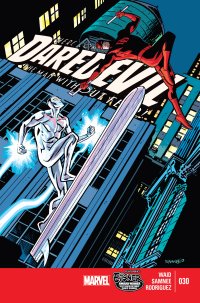 Daredevil demonstrates just why it keeps winning all those darned awards, by telling a nicely self-contained cosmic-superhero story that harks back to the sheer fun of the Marvel comics of the 60’s, while remaining wholly contemporary.
Daredevil demonstrates just why it keeps winning all those darned awards, by telling a nicely self-contained cosmic-superhero story that harks back to the sheer fun of the Marvel comics of the 60’s, while remaining wholly contemporary.
For those who have inexplicably missed out on Waid’s terrific run on Daredevil, issue #30 begins with exactly enough expository dialog to bring the reader into the story, without sacrificing character, or wit, for necessity. Once past that, we get more of Waid’s clever rethinking of Matt’s powers, and his unique perspective about the role of the superhero: an alien shows up at Matt Murdock’s office, looking for Matt’s help in his dual roles as superhero, and as an attorney. Their dialog exchange is too much fun to spoil, but Waid manages to lovingly tweak some sci-fi and comic book clichés, and there’s a very Lee-Kirby feel to the scene: the alien encounter is played perfectly straight, as though it’s what any self-respecting superhero should expect now and again.
But nothing is as simple as it seems (not even blind super-powered lawyers conversing with interstellar clients), and when the Silver Surfer shows up (which would have been a nice reveal to save for the reader, but there he is right on the cover), the story gets turned upside down, and as the Surfer and Daredevil team up against the alien threat, Waid and artist Chris Samnee give us one of his most giddily entertaining scenes yet, with Matt hopping on the Surfer’s board for what would be a rare treat for any Earth-bound character. His glee at the opportunity is infectious: on the one hand, the seriousness of the threat is never in question, but nevertheless, we’re OK with Daredevil spending some time just savoring the thrill ride. And while the story is neatly tied up by issue’s end, the sense of ongoing continuity is honored as well, with a disturbing reveal for Matt, to move us forward into the next part of the storyline.
For the thirty issues and counting of Waid’s term on Daredevil, he’s had a sequence of artists, including Paolo Rivera and Marcos Martin, each of whom seems even more ideally suited to the title than the last, and Samnee’s award-winning work (with colorist Javier Rodriguez) keeps the streak alive. His briskly-sketched detail brings character and a sense of place to Matt’s cluttered office and his beleaguered staff, but he goes big and bold for the scenes of the heroes soaring in and around the New York skyline; the sequence of Matt shedding his street clothes for his costume as he and the Surfer crash through a window and tumble toward the streets below sums up what makes this comic so great: the absurd fun of the superhero concept appreciated at face value, never taken over-seriously, but never played for cheap laughs or snark, either. Comics like this are why the genre’s not wholly dead just yet.
Avengers #18 Rating: Out of a Possible 5 Stars Out of a Possible 5 Stars Out of a Possible 5 Stars




Avengers Assemble #18 Rating: 




Daredevil #30 Rating: 



